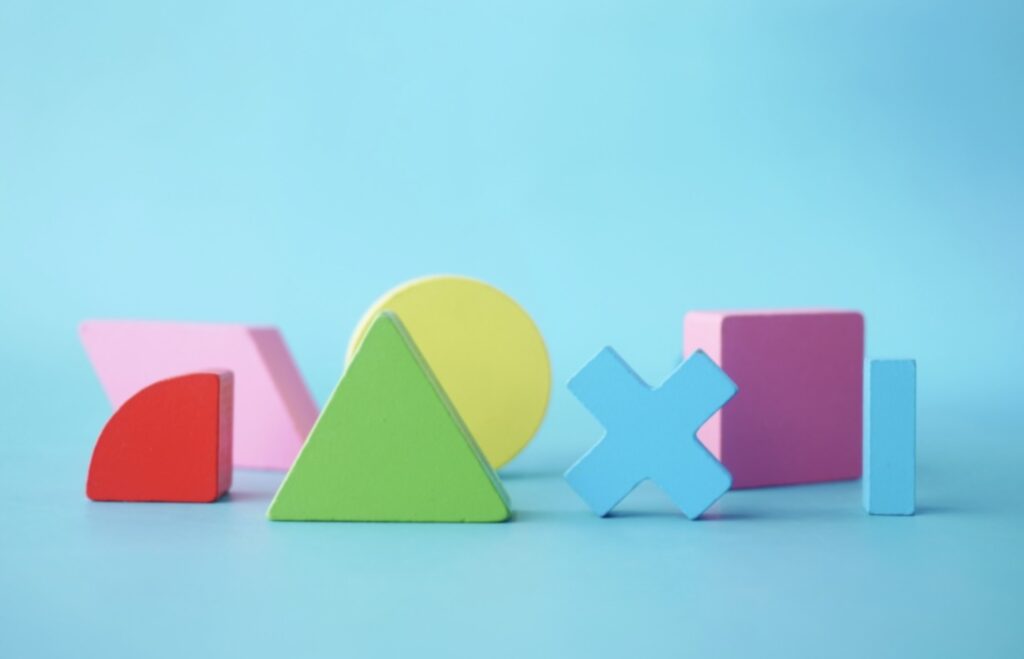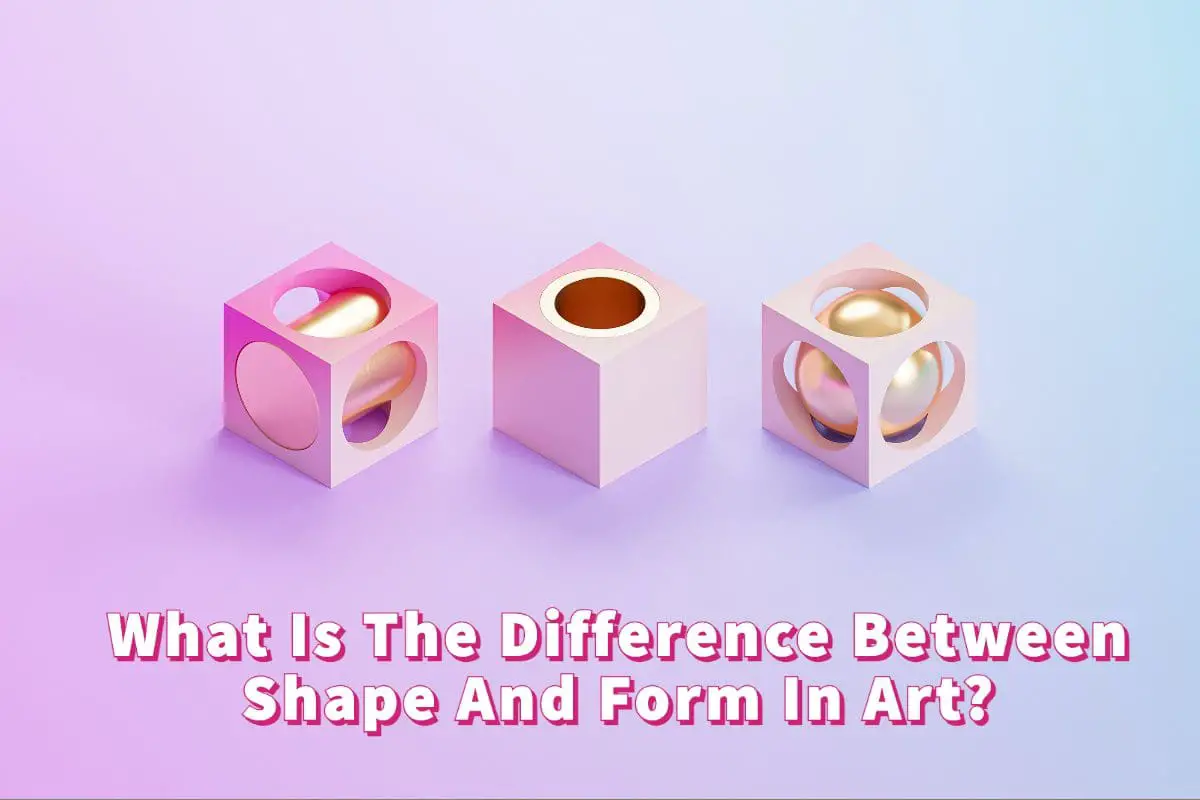Shape and form are two words that are used interchangeably in art. They may seem like the same thing, but they are not.
The word shape mainly refers to flat, simple 2-D drawings; the shape of a 2-D drawing would have a length and width. A form is more complex and is 3-D, such as a sphere, cube, or cone. The word form has a dual meaning in art, referring to various elements that make up art. The form is essential for Formalism, abstract art, and biomorphic art.
Table of Contents
- Shape Vs. Form In Art
- Form and Art
- Form In Formalism, Abstract Art, and Biomorphic
- The Significance of Form and Shape in Art: 8 Reasons Artists Must Understand Them
- 10 Distinctions Between Form and Shape & The Importance of Understanding 2-D vs 3-D in Art
- Frequently Asked Questions
- Related Questions
Shape Vs. Form In Art
To understand shape and form in art, we must understand some fundamental differences between shape and form. Form and shape have some similarities but also some very distinct differences.
Comparison of Shape and Form in Art
Below is a table to compare the basic meanings of shape and form in art.
| Shape | Form |
| 2-D | 3-D |
| Rectangles, circles, triangles, and squares | Sphere, Cube, Cones |
| Has Length and Width | Has Length, Width, and Height |
| More Simple Figures | Complex Forms |
| It exists in Flat and Simple Drawings, prints, and paintings | Exists Beyond Space of Shapes |
As you can see from the above table, shape and form are not precisely the same. The main difference is that a shape is flat, and a form has some dimension or 3-D aspect.
Even though shape and form are two different terms, they are both essential elements for the artist to understand. The term shape can be relatively straightforward in art, but the word form can have two meanings.
Form and Art
Art forms can have a dual meaning; the form can be confusing for art and artists. The Tate in London said it best when they defined form in art as:
“In relation to art the term form has two meanings: it can refer to the overall form taken by the work – its physical nature; or within a work of art it can refer to the element of shape among the various elements that make up a work.”
TAte – London
According to this definition, form in art has two meanings. One is the form in the work of art, and the other is the elements of the shape that make up the work of art.
Form In Formalism, Abstract Art, and Biomorphic
The form has also influenced different types of art, such as Formalism, Abstract Art, and Biomorphic art. All of these types of art are influenced by form in art.
Formalism
Formalism is the study of art entirely based on analyzing its form. Form, in this case, means what the art looks like and the way the art is made.
Formalism’s most critical aspect of a work is its form; the visual elements are essential in formal art. The subject matter, meaning, or what the artist conveys is not as important as the art forms.
A formalist art critic would review and look at art in terms of the qualities of the color, brushwork, form, line, and composition. It would not be about the subject matter or the meaning the artist is trying to convey.
Formalism came about because of Impressionism and the post-impressionism movements, where the emphasis was placed on the visual aspects of the artwork. An example of this is many of the paintings by Cezanne.
In 1890, the post-impressionism painter and writer Maurice Denis published a manifesto where he emphasized the visual pleasures of art and the form in art. Denis wrote:
“Remember, that a picture, before it is a picture of a battle horse, a nude woman, or some story, is essentially a flat surface covered in colours arranged in a certain order.”
Maurice Denis
The writings of Denis have become one of the most quoted texts in modern art; many artists agree with Denis that the form in art is one of the most important things.
Abstract Art
The Bloomsbury writer Clive Bell, in his 1914 book called Art, was writing about the notion of significant form. Significant form means that the form can convey a meaning for art.
The thought that form can convey meaning in art quickly led to the Abstract movement in art. Abstract art is defined as:
“Abstract art is art that does not attempt to represent an accurate depiction of a visual reality but instead use shapes, colours, forms and gestural marks to achieve its effect.”
Tate – London
In Abstract art, the use of forms is essential. Forms such as geometric shapes and even marks are all critical. Abstract art’s definition states that abstract art does not attempt to depict a visual reality; instead, abstract art is about the shapes, colors, forms, and marks to achieve the desired effect.
Biomorphic
When speaking of form in art, we must also talk about biomorphic and what it means to art. Biomorphic is defined as:
“Biomorphic forms or images are ones that while abstract nevertheless refer to, or evoke, living forms such as plants and the human body.”
Tate – London
Even the word biomorphic relates to forms in art; the word bio comes from the Greek word meaning life, and morph means form. The literal translation of the work biomorphic means “life form.”
Biomorphic in art means artists who use forms, but they use them to refer to something living as a plant, person, or even animal.
Joan Miro, Jean Arp, Henry Moore, Barbara Hepworth, and Louise Bourgeois were significant artists who practiced the biomorphic art form.
Shape and form may seem the same thing, but they are very different in art and have profound differences. The differences are essential for all artists to understand.
The Significance of Form and Shape in Art: 8 Reasons Artists Must Understand Them
The world of art is vast and intricate, with countless elements and principles that artists employ to create their masterpieces. Among these, form and shape stand out as fundamental building blocks that give art its essence and structure.

Both novice and seasoned artists recognize the importance of these elements and for good reasons.
Here are eight compelling reasons why understanding form and shape is crucial for artists:
- The Foundation of Visual Language: Just as words are the foundation of written and spoken language, form and shape serve as the foundational vocabulary for the visual language of art. Artists use the initial components to translate their visions into tangible creations.
- Creating Depth and Dimension: While shape pertains to two-dimensional objects, form adds the third dimension, bringing depth and life to a piece. Mastering both allows artists to play with perceptions, making a flat canvas seem three-dimensional and alive.
- Guiding Viewer’s Eye: Form and shape can guide the viewer’s eye through a composition. By understanding how these elements interact, artists can create focal points, balance, and flow in their work, ensuring that the viewer’s gaze moves as intended.
- Conveying Emotions and Concepts: Shapes can evoke feelings and represent ideas. For example, circular shapes might denote unity or eternity, while jagged forms could produce tension. By harnessing the power of these elements, artists can communicate complex emotions and concepts.
- Creating Balance and Harmony: Mastery of form and shape helps artists achieve balance in their work, whether it’s through symmetry or asymmetry. This understanding ensures that no part of the artwork feels out of place or overwhelming.
- Influencing Interpretations: Form and shape can lead to various interpretations of a piece. An artwork’s meaning can shift based on how these elements are employed, allowing artists to engage viewers in thought-provoking ways.
- Enhancing Aesthetic Appeal: Beyond deep meanings and interpretations, art is also about beauty. Artists can skillfully use form and shape to create visually captivating pieces, drawing viewers in and leaving a lasting impression.
- Link to Other Art Elements: Form and shape don’t exist in isolation. They are intrinsically linked to color, texture, and space. By understanding form and shape, artists better grasp how these elements intertwine, leading to richer and more cohesive artworks.
Form and shape are not mere tools in an artist’s toolbox; they are the essence of visual expression. For artists striving to make impactful and memorable art, delving deep into the intricacies of form and shape is beneficial and essential.
10 Distinctions Between Form and Shape & The Importance of Understanding 2-D vs 3-D in Art

- Dimensionality: At its most fundamental, shape pertains to two-dimensional (2-D) space and is flat. It can be seen in length and width. Conversely, form relates to three-dimensional (3-D) objects and involves length, width, and depth.
- Perception of Depth: Shapes lack depth, giving them a flat appearance, while forms have depth, giving them volume and a more tangible feel.
- Shadows and Highlights: In art, when light interacts with form, it creates shadows and highlights, offering a more realistic representation. Shapes don’t have the depth or dimension to interact with light similarly.
- Geometric Representation: Circles, squares, and triangles are examples of shapes. Their 3-D counterparts are spheres, cubes, and pyramids, which are forms.
- Tactile Nature: While visually perceiving a shape, you can both see and feel a form, making it tangible.
- Complexity in Art Creation: Rendering form, especially in painting and drawing, requires a deeper understanding of light and perspective to convey its 3-D nature, while shapes can be depicted more directly.
- Usage in Composition: In art composition, shapes often work as the basic outline before the artist adds depth to transform them into forms.
- Movement and Position: The way an observer sees a form can change based on their position relative to the object due to its three-dimensional nature. A shape remains consistent in its appearance, regardless of viewpoint.
- Space Occupation: Shapes are confined to the space within their boundaries on a flat plane. Forms occupy and define space in three dimensions.
- Conceptual Difference: Shape is more about defining space on a flat surface, often working with negative space. Form is about creating the illusion or the reality of volume and mass.
Importance of Understanding 2-D vs 3-D in Art:
- Foundation for Artistic Creation: Grasping the distinction between 2-D and 3-D is foundational for artists. Whether sketching a preliminary outline (2-D) or sculpting a statue (3-D), the artist’s understanding of dimensions profoundly impacts the creation process and final product.
- Enhancing Visual Literacy: Recognizing the interplay between 2-D and 3-D elements enriches the viewer’s or artist’s art experience. It aids in interpreting intent, understanding depth and space, and appreciating the complexity of a piece.
While both form and shape are fundamental elements in the visual arts, their differences are crucial. They contribute uniquely to the overall impact and message of the artwork. Understanding the dichotomy between 2-D and 3-D enriches both the creation and appreciation of art.
Anita Louise Art is dedicated to art education, great artists, and inspiring others to find and create their art. We love art that uplifts and inspires. #ArtToMakeYouSmile! #ArtToMakeYouHappy!
If you are interested in seeing any of my art, you can find out more by clicking here. If you are interested in what inspires me and my paintings, you can discover more by clicking here.
We have a free newsletter and would love you to be part of our community; you can subscribe to the newsletter by clicking here. If you have any questions, I would be happy to talk to you. You can reach me, Anita, by clicking here.
Subscribe to our Anita Louise Art YouTube Channel with great videos and information by clicking here.
Join us for our podcast “5 Minutes With Art.” Spend just 5 minutes a week with us to discover and learn about great art and artists. You can find out more about our podcast by clicking here.
Frequently Asked Questions
What is the definition of shape in art?
Shape in art refers to the two-dimensional area that is defined by a boundary, such as a line or color and does not have depth.
What is the definition of form in art?
Form in art refers to an artwork’s three-dimensional aspect with height, width, and depth.
What is the difference between shape and form in art?
The main difference between shape and form in art is that shape is two-dimensional and has no depth, while form is three-dimensional and has height, width, and depth.
Can shapes be used to create form in art?
Yes, shapes can be used to create form in art. By arranging and overlapping shapes, an artist can create the illusion of three-dimensional form.
What are some examples of shapes in art?
Some examples of shapes in art include circles, squares, triangles, and rectangles.
What are some examples of forms in art?
Some examples of forms in art include cubes, spheres, cylinders, and pyramids.
How can an artist use shape and form to create contrast in their artwork?
An artist can use the contrast between shape and form to create visual interest in their artwork. For example, they may use angular shapes to create tension or organic forms to create a sense of flow.
How can an artist use shape and form to create depth in their artwork?
An artist can use overlapping shapes and forms to create the illusion of depth in their artwork. Placing forms in the foreground, middle ground, and background can create a sense of spatial depth.
How can an artist use shape and form to create texture in their artwork?
An artist can use variations in shape and form to create a sense of texture in their artwork. For example, they may use irregular shapes to create a rough texture or use rounded forms to create a smooth texture
Can an artwork contain both shapes and forms?
Yes, an artwork can contain both shapes and forms. An artist may use flat shapes in the background and three-dimensional forms in the foreground to create a sense of depth.
Related Questions
What Is The Difference Between Fine Arts and Visual Arts?
Fine art is a broad term used to describe many different types of art; one of the arts under the umbrella of fine art is visual arts. Fine arts can include arts such as music, theatre, dance, literature, and art forms. In contrast, Visual art is about only visual arts such as painting, sculpture, or filmmaking.
By clicking here, you can discover more by reading What Is The Difference Between Fine Arts and Visual Arts?
Is Procreate Easier Than Photoshop? What One Should An Artist Learn?
Procreate is a much easier computer program to learn than Photoshop, especially if you are new to the Adobe program. The Procreate program is a great computer program to lay out your artwork before painting on the canvas. Photoshop can also design your artwork, but as it is a more robust program than Procreate, it will take much longer to master.
You can discover more by reading Is Procreate Easier Than Photoshop? What One Should An Artist Learn? by clicking here.


